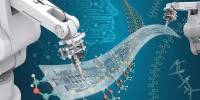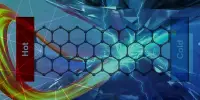Researchers have devised a new measurement and imaging method that can discern nanostructures smaller than the diffraction limit of light without the use of dyes or labels. The research is an essential step toward developing a new and powerful microscopy tool that could one day be used to observe small aspects of complicated samples that traditional microscopes and techniques cannot.
The new technology, described in Optica, is a variation on laser scanning microscopy, which employs a highly focused laser beam to illuminate a material. The researchers improved on the technique by measuring not only the brightness, or intensity, of the light after it interacts with a specimen under study, but also identifying additional factors stored in the light field.
“Our approach could help extend the microscopy toolkit used to analyze nanostructures in a range of substrates,” said Peter Banzer of the University of Graz in Austria, who led the research team. “When compared to super-resolution approaches based on a comparable scanning methodology, our method is completely non-invasive, requiring no fluorescent molecules to be introduced into a specimen prior to imaging.”
The researchers demonstrate that they can estimate the position and size of gold nanoparticles with several nanometers of accuracy, even when many particles are interacting. “Our unique approach to laser-scanning microscopy could bridge the gap between ordinary microscopes with low resolution and super-resolution techniques that necessitate specimen modification,” Banzer added.
Our approach could help extend the microscopy toolkit used to analyze nanostructures in a range of substrates. When compared to super-resolution approaches based on a comparable scanning methodology, our method is completely non-invasive, requiring no fluorescent molecules to be introduced into a specimen prior to imaging.
Peter Banzer
Capturing more from light
A light beam is swept across the sample in laser-scanning microscopy, and the transmitted, reflected, or scattered light from the sample is measured. Although most microscopy methods detect the intensity, or brightness, of light coming from the sample, other aspects of the light, including as its phase, polarization, and scattering angle, contain a wealth of information. The researchers analyzed the geographical resolution of the intensity and polarization information to capture this additional information.
“Light’s phase and polarization, as well as its intensity, fluctuate spatially in a way that combines minute characteristics about the sample with which it interacts, much like the shadow of an item tells us something about the shape of the object itself,” Banzer explained. “However, if only the overall light power is assessed after the encounter, most of this information is disregarded.”

They showed the novel method by studying basic samples containing metallic nanoparticles of varying sizes. They accomplished this by scanning the region of interest and then capturing polarized and angle-resolved pictures of the transmitted light. The measured data was evaluated using an algorithm that creates a model of the particles that automatically adapts to resemble the measured data as precisely as possible.
“Despite the fact that the particles and their distances were far tiny than the resolution limit of many microscopes, our approach was able to resolve them,” Banzer added. “In addition, and perhaps more importantly, the algorithm was able to offer other parameters about the sample, such as the specific size and position of the particles.”
The researchers are currently striving to improve the procedure so that it can be utilized with more complex samples. The approach’s usefulness can further be expanded by adjusting the structure of the light that interacts with the sample and introducing artificial intelligence-based technologies into the picture processing phases. On the detecting front, the authors and other experts are presently working on a particular camera as part of a European project called SuperPixels. This next-generation detecting gadget will be capable of resolving polarization and phase information in addition to intensity.
“Our discovery is another another evidence of the critical role that light structure may play in optics and light-based technologies,” stated Banzer. “Many intriguing applications and phenomena have been demonstrated already, but there is more to come.”
















